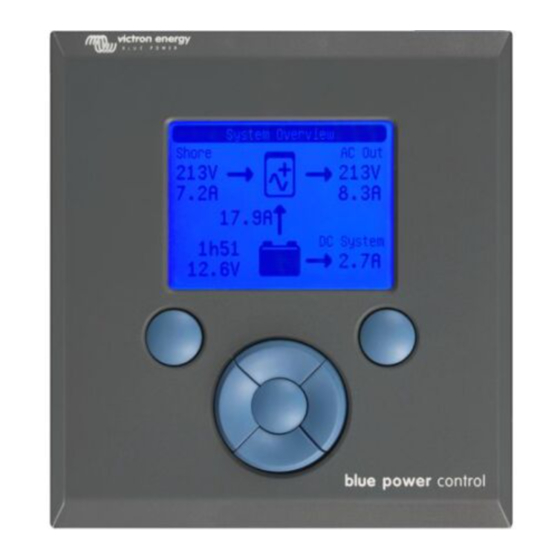Table of Contents
Advertisement
Quick Links
Advertisement
Table of Contents

Summary of Contents for Victron energy VE.Net
- Page 1 VE.Net to VE 9-bit RS485 protocol Converter (VVC) USER MANUAL INSTALLATION MANUAL...
- Page 2 EXCEED THE PURCHASE PRICE OF THE VICTRON ENERGY PRODUCTS DESCRIBED HEREIN. Victron Energy B.V. reserves the right to revise and improve its products as it sees fit. This publication describes the state of this product at the time of its publication and may not...
-
Page 3: Table Of Contents
Index oduction................3 Introduction to VE.Net............3 The VE.Net to VE 9-bit RS485 protocol Converter (VVC)3 2 Supported Devices ..............4 nstallation and s etup of your VVC .......... 4 Requirements ..............4 Wiring and jumpers............. 5 4 Using the VVC................7 5 Changing the device name ............ -
Page 4: Ntr Oduction
This means that the charger for example can get information from the battery controller to optimize the charge current. It is possible to control and monitor all your VE.Net devices from a single VE.Net compatible control panel. This saves space and allows you to control all your devices from one place. -
Page 5: Supported Devices
• Two UTP cables, each with two RJ45 connectors (one for VE.Net, and one for VE 9-bit RS485) • VE.Net Panel (VPN) (Must have a software version of 1.07 or higher) Optionally, you may also wish to connect a traditional remote panel. -
Page 6: Wiring And Jumpers
3.2 Wiring and jumpers To connect the VVC to a VPN or other VE.Net device, use a standard straight UTP cable with RJ45 connectors. The total length of UTP cables in a VE.Net network should not exceed 100 meters. Connect one of the UTP cables to your chosen device (Phoenix multi, charger etc), and plug the other end into one of the sockets on the VVC labelled VE 9-bit. - Page 7 Figure 1 – Jumper locations Connect the power terminals to the battery using 1.5mm wire.
-
Page 8: Using The Vvc
Figure 2 – Wiring diagram 4 Using the VVC When power is first applied to the VVC, the status LED will flash rapidly for approximately 2 seconds. The VVC will then begin communicating with the VE 9-bit device, and determine which features it supports. Whenever there is communication between the VVC and the VE 9-bit device, the status LED will blink slowly. -
Page 9: Changing The Device Name
VVC that you wish to rename, Switched On and scroll down until you see the “Settings” menu. Press “Enter” to enter this menu, and then scrol down to the “VE.Net Setting s” Settings menu. Press “Enter” once more [Press Enter] to display “Device name”. -
Page 10: Remote Panels
VVC will automatically resume control of the switch and shore current settings. 7 Alarms The VVC can cause the VE.Net panel to generate an alarm if a fault is detected on the connected device. The VVC supports 4 alarms: overload, low battery, high temperature, and connection lost. -
Page 11: Menu Structure
Setup* General* Transfer Switch* Inverter* Charger Settings* VE.Net Settings* Advanced Menu* Figure 3 - VVC menu layout If the panel has been set to “user” access level, items marked with * are hidden. For more information on access levels, refer to your VPN manual. - Page 12 Table 1 – VVC menu summary Items marked with * require a panel restart before the changes will be properly registered. Name Information / Details Setting Root menu Device Switch Setting Use this to turn the device on or off Device State Information Indicates the current...
- Page 13 Inverter Information The frequency of the Frequency inverter output. Shore cur. Setting The maximum current to limit draw from the shore supply. Charge Setting The maximum current percentage of the charge current setting to utilise. General menu Sys. Setting The frequency of the Frequency mains supply in your region.
- Page 14 Transfer Switch menu Wide Input Setting Allows the AC input Freq. frequency to be anywhere from 45 – 65 AC Low Setting The voltage at which the Discon. transfer switch will disconnect the AC supply, and switch to the inverter. AC Low Setting The voltage above the...
- Page 15 Inverter menu Inverter Setting The desired output Voltage voltage of the inverter. DC Low Setting The inverter will switch Shutdown off when the battery voltage drops to this level. DC Low Setting The inverter will restart Restart when the battery voltage rises this far above the shutdown voltage.
- Page 16 Charger Settings menu Enable Setting Switch the charger on or Charger off. Charging Setting Select which charging Chars algorithm should be used. Battery Type Setting Select the type of battery that is connected. Charge Setting The amount of current Current used to charge the battery.
- Page 17 10 hours. Weak AC Setting Enable this setting if Input poor A.C. input cause charging problems. VE.Net Settings menu *Device Name Setting The name that will appear in the VPN’s device menu. Device Information The device address for Address the VVC.
- Page 18 Advanced menu DC Voltage Information Displays the measured ripple voltage of the DC input. Max AC cur. Setting That value that will be used for the shore current limit, if no VVC or remote panel are connected to the multi. Auto Shore Setting If this setting is enabled,...
- Page 19 -18-...
- Page 20 Victron Energy B.V. De Paal 35 1351 JG Almere PO Box 50016 1305 AA Almere The Netherlands w w w . v i c t r o n e n e r g y .c o m...




Need help?
Do you have a question about the VE.Net and is the answer not in the manual?
Questions and answers